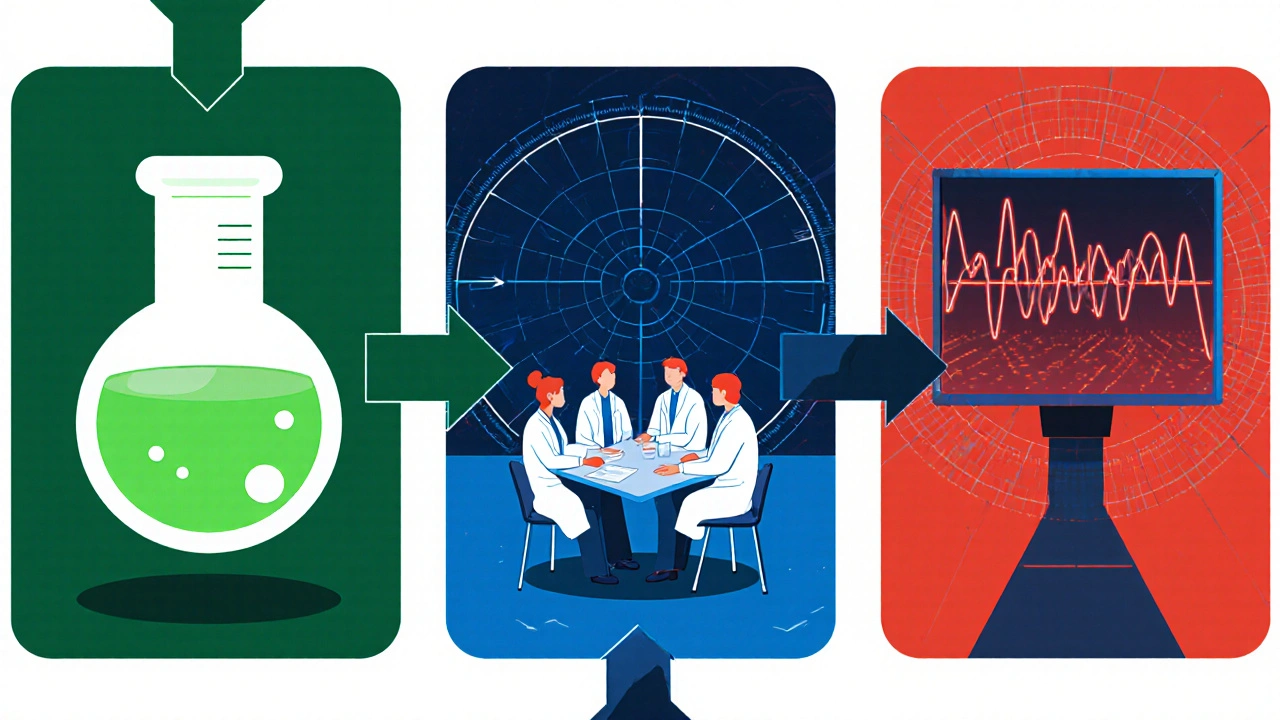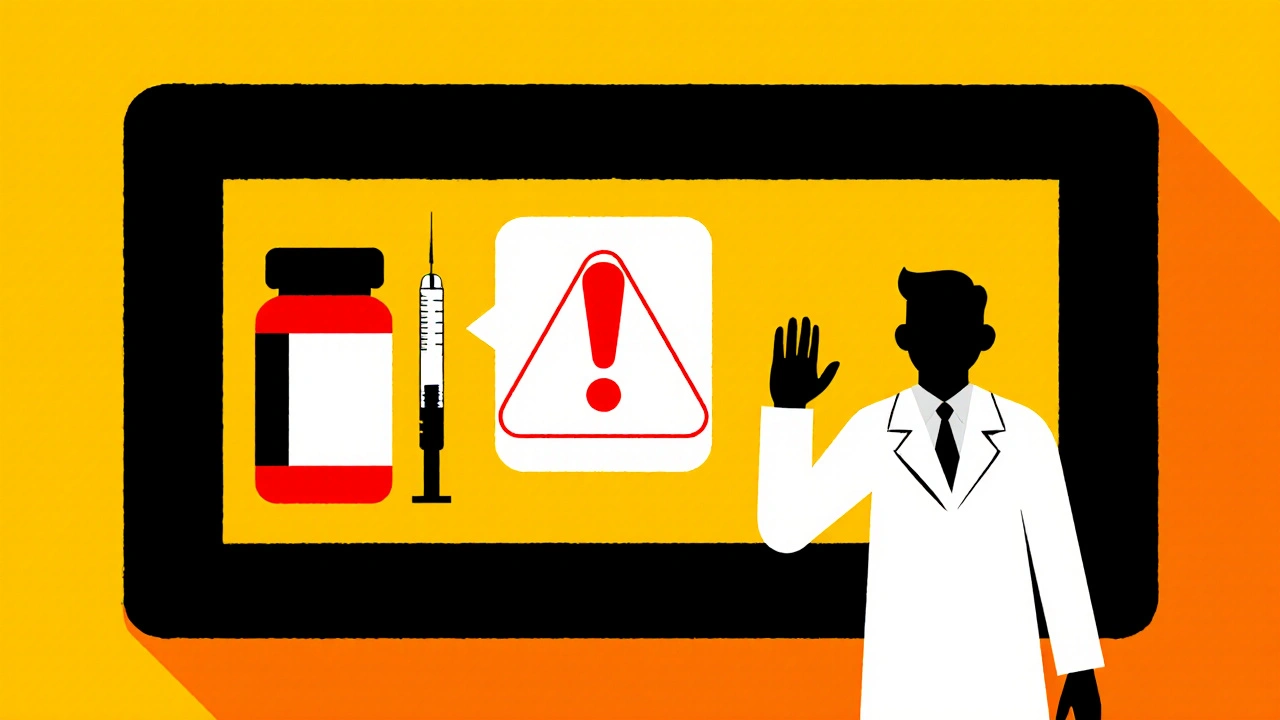Black Box Warning Decision Tool
Assess Risk-Benefit Ratio
This tool helps clinicians evaluate the risk-benefit ratio of medications with FDA black box warnings based on patient-specific factors. Use the STEPS framework (Safety, Tolerability, Effectiveness, Price, Simplicity) for clinical decision-making.
Risk Assessment Results
Additional Information
Rosiglitazone carries a black box warning for increased risk of myocardial infarction and heart failure. Prescribing rates dropped 70% after the warning was issued, but it still affects over 3.8 million patients.
Did you know that over 400 prescription drugs carry the FDA’s most severe safety label? Those eye‑catching black‑bordered boxes aren’t just decorative - they signal a risk of death or serious injury that every prescriber must weigh.
What Exactly Is a Black Box Warning?
When the Black Box Warning appears as a bold, black‑bordered box at the very start of a drug’s label, package insert, and promotional material, the FDA is saying: “Stop and think before you prescribe.” The practice dates back to the Kefauver‑Harris Amendments of 1962, which first demanded rigorous proof of safety and efficacy. The modern black‑box format was codified in later FDA guidance, and today it remains the agency’s strongest safety communication.
When Does the FDA Issue a Black Box Warning?
The agency only reaches for a boxed warning after a multi‑step review:
- Pre‑clinical research flags a serious adverse signal.
- Human trials confirm the risk is not just a fluke.
- Post‑marketing surveillance (FAERS, MedWatch) uncovers severe outcomes in a broader population.
- The FDA’s safety review panel decides the risk is “serious enough to merit immediate prescriber attention.”
GoodRx’s 2022 analysis outlines three concrete scenarios that trigger a black box:
- Risk that could outweigh benefit for certain patients.
- Side effects that can be mitigated only with strict monitoring or avoidance of drug interactions.
- Special restrictions, such as required training or contraindication for a specific demographic.
How Black Box Warnings Compare to Other FDA Alerts
Not all FDA safety messages carry the same weight. The table below shows the three most common communication levels.
| Level | Placement in Label | Trigger Criteria | Typical Impact on Prescribing |
|---|---|---|---|
| Black Box Warning | First page, bold black border | Life‑threatening or serious injury risk confirmed | Prescribers often require extra monitoring or consider alternatives |
| Standard Warning/Precautions | Mid‑section of label | Known adverse events, but less severe | May influence dosage or monitoring but less likely to stop use |
| FDA Safety Alert (e.g., Drug Safety Communication) | Separate FDA press release, sometimes added to label | New safety signal identified post‑approval | Can prompt rapid prescribing changes, especially if publicized |

Real‑World Impact: The Rosiglitazone Case Study
Research cited on Wikipedia shows that when rosiglitazone received a black box warning, its prescriptions dropped by 70 %. Yet the drug still affected 3.8 million patients because the warning coincided with intense media coverage and scholarly articles. By contrast, pioglitazone-subject to a similar advisory but with less fanfare-saw a modest decline. The lesson? A boxed warning’s power is amplified by how it’s communicated beyond the label.
What Doctors Should Do When Facing a Black Box Warning
The American Academy of Family Physicians (AAFP) recommends the STEPS approach-Safety, Tolerability, Effectiveness, Price, Simplicity-when evaluating any medication, especially those with a black box. Here’s a quick checklist for clinicians:
- Read the boxed warning in full; note any monitoring parameters or contraindications.
- Assess the patient’s comorbidities, current meds, and risk factors.
- Discuss the specific risk with the patient, using absolute numbers when possible.
- Consider alternative therapies that lack a black box, if efficacy is comparable.
- Document the risk‑benefit discussion in the chart.
- Report any adverse events to MedWatch or the FDA’s Adverse Event Reporting System (AE‑RS).
Dr. Meghan Lehmann of the Cleveland Clinic emphasizes that a black box does not automatically mean “don’t use it”-it means “use it with caution and informed consent.”
Resources for Staying Updated
Clinicians and patients can tap into several free tools:
- Drug Effectiveness Review Project - independent drug effectiveness summaries.
- Consumer Reports’ Best‑Buy Drugs website - plain‑language safety overviews.
- The FDA’s Drug Safety Communications page - latest alerts and label changes.
- FAERS public dashboard - searchable database of reported adverse events.
Registering for FDA’s email alerts ensures you get new boxed warnings the moment they’re issued.
Key Takeaways
- A black box warning signals a risk of death or serious injury; it is the FDA’s highest‑level drug safety label.
- Over 400 drugs carry a boxed warning as of 2022, and the number is growing as post‑marketing data accumulate.
- Prescribers should follow the STEPS framework, discuss risks openly, and document the decision.
- Reporting adverse events via MedWatch or FAERS helps the FDA refine warnings.
- Staying current through FDA communications, independent review sites, and professional societies is essential.
Frequently Asked Questions
What is a black box warning?
It is a bold, black‑bordered notice on a drug’s label that the FDA requires when the medication has a serious or life‑threatening risk. The warning appears at the very beginning of the prescribing information.
How many drugs have black box warnings?
More than 400 prescription drugs carried a boxed warning in 2022, according to Medical News Today.
Where can patients see the black box warning?
The warning is printed in the drug’s package insert, on the prescription label, and in any FDA‑approved promotional material. Many pharmacies also list it on their websites.
What should a doctor do before prescribing a medication with a black box?
Review the specific risk details, assess the patient’s health status and other meds, discuss the warning with the patient using absolute risk numbers, consider safer alternatives, and document the conversation.
How does the FDA decide to add a black box warning?
After thorough evaluation of pre‑clinical data, clinical trial results, and post‑marketing surveillance (FAERS, MedWatch), the FDA’s advisory committees vote on whether the risk meets the threshold of “serious and potentially life‑threatening.” If yes, the agency issues a boxed warning.
Can a black box warning be removed?
Yes. If new evidence shows the risk is lower than originally thought, the FDA may revise or rescind the warning. This requires a formal label amendment.





6 Comments
the sagar-24 October 2025
The FDA is just another tool for the global pharma cartel.
Shannon Stoneburgh- 2 November 2025
Black box warnings are not just paperwork; they highlight drugs that can literally kill you if misused. Doctors need to read them carefully and talk to patients about the real risks. Ignoring a boxed warning can lead to lawsuits and harm. The simple truth is, a warning means the drug has serious side effects that outweigh benefits for many people. Stay informed, stay safe.
Nathan Comstock-10 November 2025
Listen up, the whole point of a black box is that the FDA has seen enough bad outcomes to shout "danger!" History shows us drugs like thalidomide and rosiglitazone got boxed warnings after tragic fatalities. This isn’t a bureaucratic overreach; it’s a lifesaver. If a medication carries that bold border, you better have a solid plan for monitoring. Otherwise you’re gambling with your patient’s health.
Corrine Johnson-18 November 2025
Consider the black box warning as a stark reminder, a flashing beacon, a signal that mortality risk looms, and that the FDA has compiled data, analyzed trends, and issued a mandate; it is not a trivial label, it is a grave caution, and clinicians must heed it, for the alternative is preventable harm.
Jennifer Stubbs-26 November 2025
From an analytical standpoint, black box warnings serve as a data-driven flag based on post‑marketing surveillance, clinical trial outcomes, and adverse event reporting. They force prescribers to weigh risk versus benefit more rigorously. However, not all providers integrate these warnings consistently, leading to variability in patient safety. Continuous education and system‑level alerts can help bridge that gap.
Abby W- 4 December 2025
Hey folks 👋, those black boxes are like red lights on the road 🚦 – you stop, look, and then decide if you can go. Ignoring them is just asking for trouble 😅. Keep an eye on them!